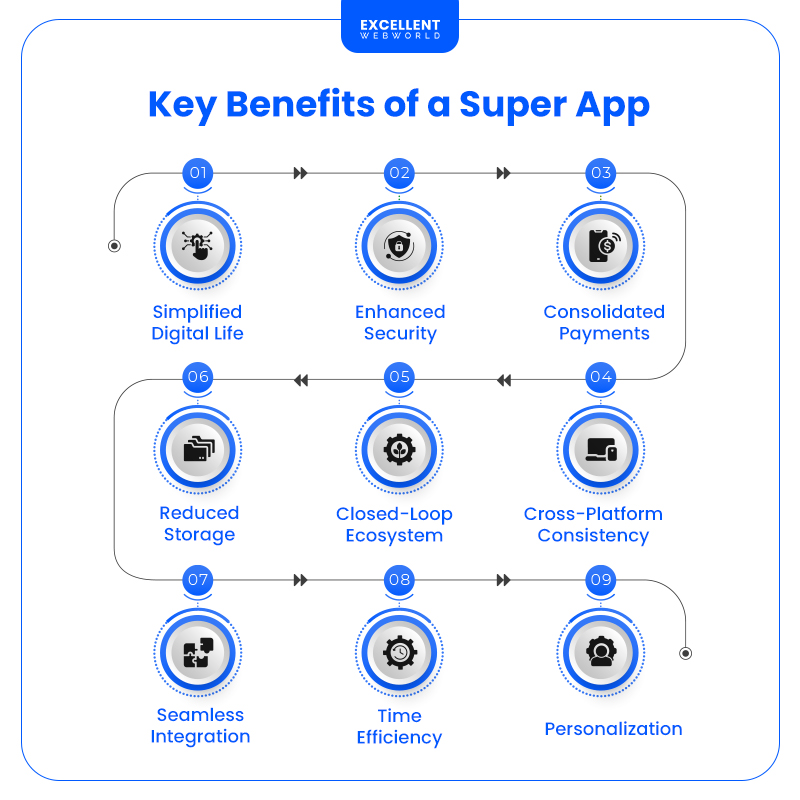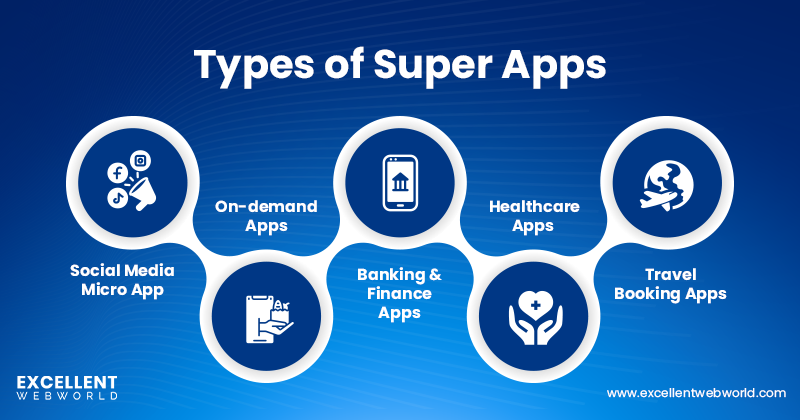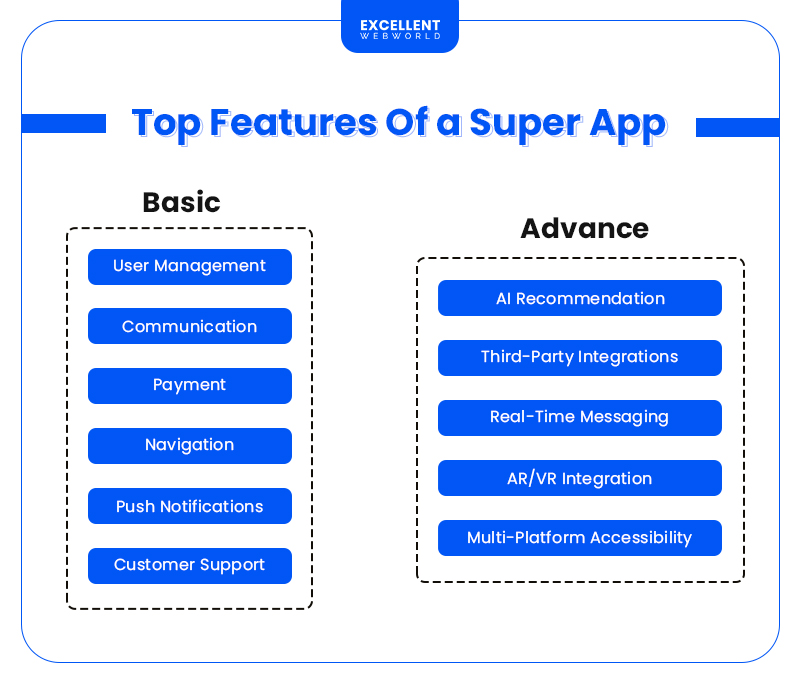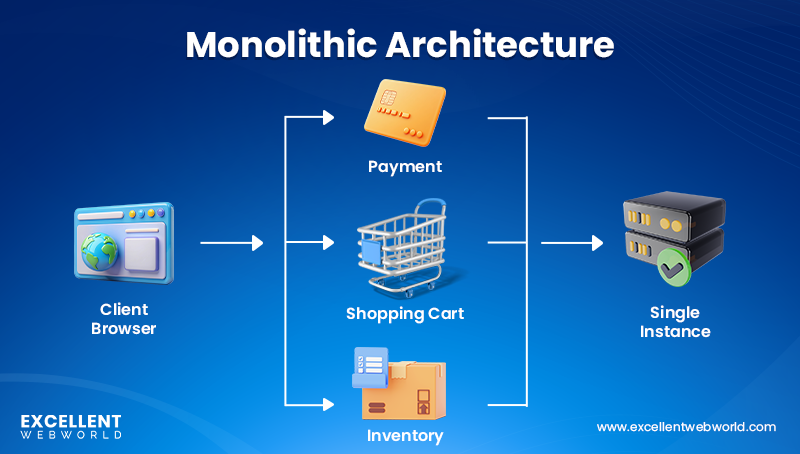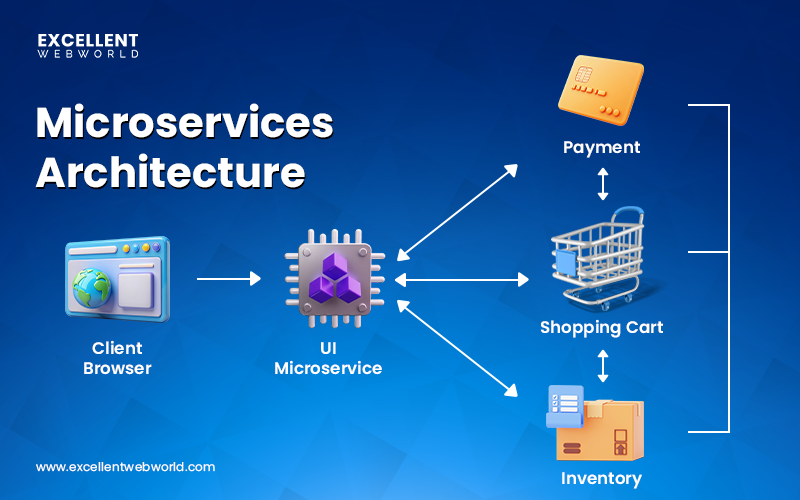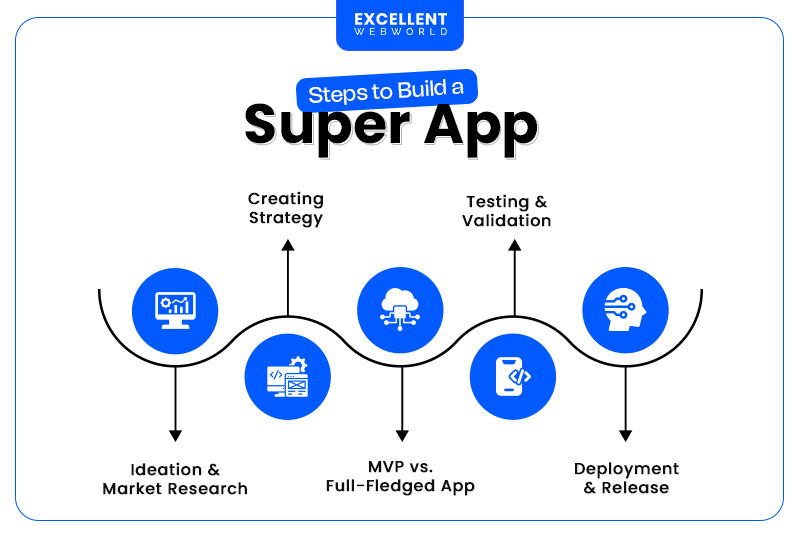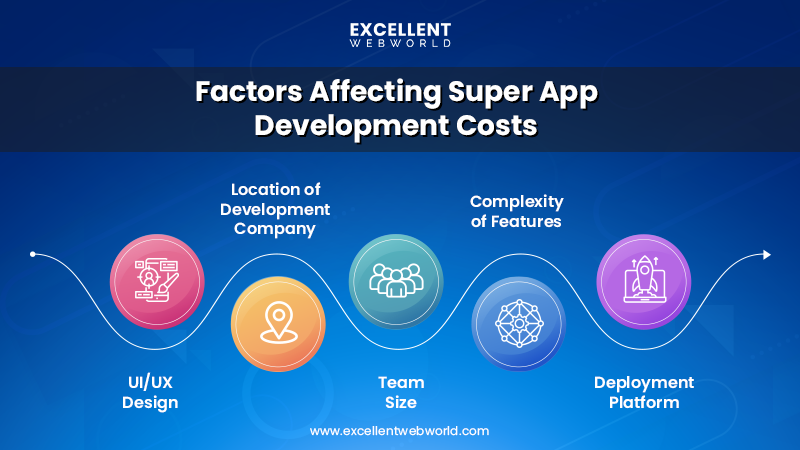Dreamed about building the next Gojek, WeChat, or Grab? One super app development that dominates an entire digital ecosystem? The way every industry is moving forward, creating a super app is not just a trend; it’s the future of user engagement, retention, and monetization. Planning only a single-purpose app development will leave you behind your competitors. Super app development is where real digital disruption begins.
Now with AI, the complete super app development process can be streamlined and become faster than usual. From personalized recommendations to automated customer service, the possibilities inside a super app are smarter and more scalable with AI and ML than ever. Entrepreneurs who act now will own the platforms people rely on daily, not just for one task, but for everything.
At Excellent Webworld, we’ve helped startups and enterprises alike turn multi-service ideas into fully functional super apps over the last 13 years. Backed by years of full-cycle development expertise and a continuous eye on emerging tech like AI and microservices, we know what it takes to build a super app that wins markets. Let’s understand everything about “what is a super app” and its development process.
Market conditions allow entrepreneurs to build a super app and generate profits. However, there are aspects to super app strategy that you need to understand. This article provides a complete guide on building a super app for your business, including types, features, costs, and more.
But before you fly high with the super application, read the manual first (what is a super app)!
What Is A Super App?
Super App is a mini-app suite that provides users access to multiple services on one platform. It is a single app accessible to smartphone users that combines diverse services for everyday personal or commercial use.
A super app architecture uses multiple micro apps to create a marketplace. This marketplace business model also allows users to add or delete mini-apps. A super app features multiple purposes and functionalities, developed either internally or by third-party developers.
What makes this app stand out is its multiple categories of services on a centralized platform. For example, a super app can provide on-demand food delivery, cab booking, and an eCommerce store for clothes in one application.
What is Super App Development?
Super app development is the process of crafting one powerful application that offers multiple services and ultimately does the job of many. It provides users with the flexibility of downloading only one app instead of downloading separate apps for chatting, shopping, booking rides, or making payments. A super app brings all these services together in one interface. You can consider it a digital mall; everything you need is just a tap away.
Developing a super app isn’t just about adding a bunch of features. It’s about designing a smooth, connected experience where users don’t feel like they’re just jumping between different apps. It asks for smart planning, the right tech team, and a clear vision of what users really want in their everyday digital life.
How Is A Super App Different From Your Traditional App?
A traditional smartphone app, especially one offering on-demand services or eCommerce products, is a niche store. It only provides one specific product or service. At the same time, a super app is like a department store, where you can get everything you need.
In terms of business opportunities, super apps are way better than traditional apps. The reach is limited if you cater to a specific niche with a single app or offer a single service. However, startups and enterprises can reach a wider audience through super apps.
Reaching more users is one of many reasons businesses turn to super app development. Rising user demand is also contributing to this trend.
Why Are Super Apps Gaining Popularity?
The super app development trend has been introduced previously in Asia. Kakao Talk in South Korea was a super app founded in 2010 before WeChat. However, such platforms are now gaining traction in countries like the US. According to a survey, 72% of US consumers are interested in a super app.
Here are some other market statistics that show how super apps are gaining popularity,
With such popularity, many entrepreneurs are considering developing a super app. But knowing what type to build is essential. As you already observed, specific categories are popular among customers for super apps, so choosing one can be complex.
What are the Key Benefits of a Super App?
There are several benefits of super app development for entrepreneurs, as well as from the user perspective. Let’s see the key advantages of developing a super app:
What Are the Industry-Specific and Development-Based Types of Super Apps?
You can divide super apps based on two different parameters:
Check out this video to explore more about types of super apps and why you should be building one:
Types of Super Apps According to Development Type
1. Consumer-Facing Super Apps
They target the general public by offering multiple integrated services on a single platform. They aim to become an essential part of users’ daily digital lives by consolidating various functions that would otherwise require separate apps.
Example: WeChat combines messaging, payments, shopping, and services in one app.
2. Employee-Facing Super Apps
They streamline internal business operations by consolidating workplace tools into a single platform. They enhance productivity by reducing the need to switch between different enterprise systems.
Example: Microsoft Teams integrates workplace chat, meetings, and business applications.
5 Types Of Super Apps According to Industry
The “SUPER” in super apps is a collection of business domains and niches. Selecting the right blend of these domains and niches can make or break the super app experience.
Here are some of the categories to consider for on demand super app development projects,
1. Social Media Micro App
Social media platforms have become an integral part of life, and people use them for various purposes. It’s not just about communicating, sharing, and connecting with like-minded people; social media has also evolved into a powerful marketing tool.
Additionally, social media has become a collaborative platform for many creators. Adding a social media app to your super app can act as a catalyst for customer engagement.
2. On-Demand Apps
On-demand apps can integrate multiple services. You can include various on-demand app ideas, such as online food ordering, taxi booking, and courier delivery, among others. You can even build a super app with all the above categories of on-demand apps.
For example, Yandex GO is a super app in Russia that combines on-demand services like,
Such apps enable customers to book multiple services from a single platform, making it a compelling option for startups to consider for their projects.
However, integrating many on-demand apps can be challenging. Startups can leverage on-demand app development companies to integrate and build API-based microapps.
3. Banking & Finance Apps
Adding a banking and finance app to the super app is crucial. If you are developing a super app, customers will use different services. When you add a banking and finance app, the entire payment process becomes seamless.
4. Healthcare-Based Apps
Adding healthcare-based apps to your super apps can be crucial for increasing the user base. For example, you can add a micro-app with a management panel allowing doctors to keep track of patients. Similarly, you can add patient-specific apps where they can digitally save health records. With EHR app integration into your super app, users can access health data anywhere.
5. Travel Booking Apps
Travel is a category of super app that many users demand. It can integrate multiple micro apps. For example, you can combine on-demand applications with the travel bookings micro-app to provide a complete experience.
Such super apps can benefit both users and businesses. On-demand startups can leverage the super app to target a wider audience, while travel businesses can make the travel experience seamless.
Deciding on the category of super app to build is the first step, but identifying and finalizing the features is crucial for your project’s success.
What Are the Top Features of a Super App?
Features are what make the super app “SUPER!” It’s important to understand that a super app is a platform for different types of apps. As the Excellent Webworld experts helped many clients to build revenue-generating features in a cost-efficient way, we curated a top features list from that experience for you. So, you can create seamless super app features by combining in-house technologies and third-party integrations.
Your super app development needs well-defined core functionalities. These features are crucial for user experience and for enabling different services.
These features facilitate the super app’s core functions, but advanced ones are needed to improve user experience.
What Are the Advanced Features in Super App Development?
Planning to build a super app with consideration of the advanced feature development can prove detrimental. Changing customer demands need advanced features. It ensures a more personalized customer experience, offering a wide range of capabilities, engagement, and user engagement.
1. AI-Enabled Recommendations
AI-enabled recommendations have been a go-to approach for many eCommerce brands, including Amazon. However, integrating an AI recommendation feature into your super app can be a complex process. You will need a custom AI model that can analyze all the services offered in the app and recommend them to users according to their needs.
However, the use of artificial intelligence extends beyond intelligent product recommendations. You can also integrate an AI-based chatbot to improve customer support. Leveraging generative AI development services, you can create an easy-to-use portal that answers every query that customers can have.
You can also customize various services using AI models to provide a highly personalized experience. For example, you can integrate AI-based chatbots for banks within your super app. Such chatbots can provide personalized financial advice, including product recommendations.
2. Third-Party Integrations
Seamless integration of third-party services and apps is crucial for on-demand super app development. It ensures your app has advanced features that enhance functionality and provide a more personalized experience. For example, you can leverage third-party services to add support for multiple languages. It allows you to cater to a larger audience with diverse demographics.
3. Real-Time Messaging
Go beyond the usual instant messaging feature that allows businesses and customers to connect. Leverage the super app tech to build features that enable customers to communicate on the platform. This will help you make a strong community on the super app.
Knowing what a super app is, you can integrate a social media micro-app. However, this feature allows the customers on your super app to connect with another rating of the services as well. This can offer valuable feedback for your platform.
4. AR/VR Integration
Super apps allow brands to add a range of services, and leveraging AR/VR technologies can transform the user experience. For example, companies can look to integrate metaverse in the super apps. This super app strategy can enable businesses to incorporate virtual events into each micro-app, thereby enhancing the overall experience.
AR/VR integration is a prominent mobile app development trend that can offer a competitive edge for your super apps. For example, using AR/VR technologies, you can allow different brands with micro-apps on the platform to provide custom virtual environments.
5. Multi-Platform Accessibility
Make your super app accessible anywhere, anytime. For example, you can collaborate with specific merchants to offer a point-of-sale (POS)- based interface that allows access to the super app in a particular location. This is especially useful for users who prefer a more hybrid shopping experience.
You can enhance the phygital experience by offering advanced payment technologies like NFC. It allows customers to make instant payments at the POS through their super app.
All these super app features need the right tech stack to create advanced and responsive functions, including a super app architecture that can handle complex processes.
What Is the Best Super App Architecture that Maximizes ROI?
A super app is all about diversity in content, services, and customer journeys. So, what services and content you blend into your super app becomes crucial. However, what is more important is the super app architecture.
A robust architecture enables startups to connect multiple microapps, string different apps, and create a unified experience.
So, what’s the super app architecture you need?
The Battle Between Monolithic And Microservices Architecture
A significant aspect of super app development is choosing the best architecture. It can be crucial for super app performance because if your backend architecture is not optimized, dealing with peak loads can be challenging. Two significant contenders are monolithic and microservices architecture!
So, which one to choose?
Well, let’s understand each of them and then decide.
Monolithic Architecture: The Conventional Approach
The conventional approach selects a monolithic architecture where each service is linked. However, dependencies are an essential bottleneck in using this architecture. If a single service goes down, the entire app will be affected, which can disrupt your super app.
Microservices Architecture: The Distributed Approach
At the same time, microservices are a smaller service suite that offers a unified response to each user’s requests. Microservices architecture allows isolating a more minor service if there are issues. This means you can isolate and update each service without disrupting the entire application.
If you consider higher availability and minimal disruptions, microservices have an edge over monolithic architecture. But, before you finalize a super app architecture, you must also consider the scalability and modularity aspects.
Scalability And Modular Design Of Super App Architecture
Scaling your super app and handling millions of requests need a robust architecture. Monolithic applications face several challenges, including scalability. You need to scale your super app to meet changing customer demand.
This is where microservices architecture has the edge over the monolithic approach. Microservices architecture supports a more distributed approach, which allows businesses to leverage modular design.
Super apps are generally built on a modular framework that allows for integrating various services and functionalities. This flexibility allows for the addition of new features and services without disrupting existing functionality.
So, choosing microservices for your project has many benefits for mobile apps, but you need the right tech stack to implement them.
What Is the Ideal Tech Stack to Build a Scalable Super App?
1. Frontend Development
iOS Development:
Android Development:
2. Backend Development
3. Database
4. API Integration
GraphQL or RESTful APIs: For robust front and backend communication, enabling efficient data fetching and manipulation.
5. User Authentication And Security
6. Cloud Services
7. Third-Party Integrations
8. Testing And Deployment
9. Analytics And Monitoring
You can build a super app with advanced features and functionalities using this tech stack. However, the most significant aspect of super app development is execution. If you can execute the project right, you can improve the ROI by 10x.
What Are Some Real-World Super App Examples that Generate High Revenue?
Here is how some of the leading giants in the industry got the execution right!
1. WeChat
Launched in 2011, WeChat has been one of China’s most popular messaging apps. However, the integration of the WeChat wallet changed the app forever. This integration and multiple services converted a messaging app into a super app.
The best part about this super app is the communities within WeChat that allow users to share updates. These communities allow users to share product recommendations and other crucial updates benefiting businesses on the platform.
2. Bolt
Bolt is a leading super app that offers multiple services, including ride-sharing, food delivery, courier services, payments, and micro-mobility. Originating in Estonia, this mobility giant is now a multi-purpose platform for many users, offering several services in one app.
It is one of the leading super app examples for entrepreneurs and taxi booking startups. Adding services like food delivery and courier with ride-hailing has been pivotal to their success across Europe and Africa.
3. Gojek
Gojek is the “Jack of all trades” app that combines ride-hailing, food delivery, online shopping, and cleaning services. It also offers medical services on the GoMed app. GoMed is a mini-service in the Bolt Super app that allows virtual consultations. Apart from the above services, this app also enables on-the-go digital payments.
4. Grab
Founded in 2012, Grab is one of the leading ride-hailing service providers. However, the transition from a ride-hailing app to a full-fledged super app has been phenomenal. It has added mini services like food delivery, financial, and express courier. Services like GrabPay have been crucial, where users also get credit for one month to use the services and pay later.
5. Rappi
Rappi is another super app known for its amalgamation of micro apps that enable food, pharmacy, and grocery delivery. It delivers a streamlined customer experience with multiple services that cater to different user needs in Mexico and eight other countries.
Now that you have some inspiration for your super app development, it’s time to understand its development process.
What Is the Step-by-Step Process to Build a Super App?
Any mobile app development process involves several steps across market research, roadmapping, development, and deployment.
Super app development involves creating a single application that offers multiple services, replacing the need for numerous individual apps.
Steps that the super app development process will involve,
Step 1- Ideation & Market Research
The ideation stage of super app development involves key activities like conducting market research, gaining feedback from peers, and ideating the platform.
When you complete the creativity and marketing research stage, you will have a defined audience for super app development.
Step 2- Build A Super App Strategy
This stage involves creating a roadmap of your super app development process, from understanding what a super app is and its features to the entire user flow. A key aspect of your super app strategy is determining the mini services you will integrate into the app. This will require collaboration with third-party services and an integration plan.
For example, if you create a super app for on-demand apps, you must integrate food delivery, ride-hailing services, and more. Leveraging an on-demand super app development company, you can integrate multiple services.
Step 3- MVP vs. Full-featured Super App Development
The next step in the super app development process is to create a minimal product version. A Minimum Viable Product(MVP) is an excellent approach to leverage an incremental iterative method. With MVP development services, you can achieve faster time to market, reduce development costs, and seamlessly integrate feedback before moving to full-scale development.
Once you build a super app MVP, the next step is to test it extensively. This involves a constant testing approach with continuous feedback integrations.
Step 4- Test Your Super App MVP
A super app has multiple services, all needing to work in sync to deliver a smoother user experience. Your MVP will have restrictive features; you must test it to ensure a seamless app experience.
Some of the testing methods you can use for MVP testing are,
Once you test the MVP, it’s time to deploy the minimal super app on the respective platform.
Step 5- Deploy Your Super App
Deploying the MVP of your super app requires consideration of compliance requirements, styling, and other prerequisites. Each mobile app platform, including Apple and Google, has specific guidelines.
Make sure your MVP meets the requirements for deployment across both native platforms. Once you deploy the beta version of your super app, monitor user interactions and make quick changes as needed. Using an agile approach, you can continuously iterate and convert the MVP into a full-fledged super app. This involves several iterations and rigorous testing to implement CI/CD for scalable deployment.
The above process is extensive, but a critical aspect that every entrepreneur needs to consider is the cost of building a super app.
How Much Does Super App Development Cost?
A custom super app can cost anywhere from $65,000 to $300,000, including designing, developing, and deploying it. However, creating an MVP will cost between $25,000 and $65,000.
In both cases, the cost of developing super apps depends on multiple factors,
| Region | Hourly Rate of Developers |
|---|---|
| US | $115-$150 |
| UAE | $60-$70 |
| Western Europe | $85-$100 |
| Australia | $75-$95 |
| Eastern Europe | $55-$65 |
| Asia | $25-$40 |
Knowing the costs helps you understand the project’s budget. However, you must also consider how a super app will earn money.
What Are the Most Effective Strategies for Monetization of Super Apps?
Earning money with super apps is relatively straightforward, with different micro-apps being part of your platform.
But how do you leverage micro-apps to your advantage?
Here are some monetization models that you can use,
1. Subscription Fees
You can add multiple services and charge subscription fees for each of them. Plus, you can also integrate a customer loyalty programs that allow customers to get discounts by subscribing to a membership. Further, you can add subscription fees for cashback when users transact through in-built wallets.
2. Advertising Revenue
With the platform’s multiple services and diversity, advertising opportunities increase. You can have higher revenue by running ads on relative products across services.
3. Featured Listings
You can create a super-app strategy where each micro-app you integrate will have featured listings. These listings will be paid, allowing your super app to earn revenue from each service on the platform.
4. Transaction Fees
In addition to the subscription for transaction discounts, you can earn money by charging transaction fees and generate revenue by charging secure payment transactions on the platform.
5. Pay Later Interest
Super apps allow you to reach more customers, and if you can implement a pay-later or credit-based model, interest revenue will be higher. You can provide EMI schemes and loans and buy now and pay later models to generate revenues.
Knowing these monetization models may seem attractive, but super apps have challenges like any other mobile app.
What Are The Challenges Of Building A Super App?
You need more than just knowing what makes a super app; you must also understand the challenges. If you don’t consider these challenges, planning your super app development will be incomplete.
1. Scaling A Super App
Considering a super app as any other mobile application for scaling can be a mistake. While scaling other apps, you consider how many user requests it can handle; super app scalability goes beyond this. You have to integrate new services and micro-apps with changing market demand.
This becomes challenging, especially with changing super app tech and integration requirements. You also need to consider the challenges of tech debt.
2. Integration Issues
Apart from the challenges of integrating different services emerging in the market, you must consider payment gateway integrations. This includes configuring your app environment for API-based integrations such as AI models or payment gateways.
However, you can overcome the challenges of integrating advanced AI models by collaborating with an AI development service.
3. Data Security
Securing user data in a super app can be challenging for any startup. All the micro-apps can access user data when users interact with the platform. Now, if one of the micro-apps has a vulnerability, it can impact the entire super app.
This is why you need to ensure the security of all the micro-apps on your platform and test your APIs for security to make integrations more secure.
4. Performance Bottlenecks
Maintaining uniform performance across services and apps within your super app is challenging. You will need continuous testing, monitoring, and fine-tuning of app performance. Another critical consideration is timely updates and how these iterations perform across devices.
You must also test the older devices’ updates to ensure a seamless user experience and backward compatibility.
5. CX Complexity
A super app’s customer experience(CX) encapsulates everything from signing up for the platform to booking a service and beyond. Ensuring seamless experience across touchpoints and user journeys can be a massive challenge.
The best way to overcome this challenge is to create a user journey map before designing the flow of your super app.
How Can Excellent Webworld Help You Overcome Super App Development Challenges?
Building a super app becomes crucial considering its challenges, features, and cost. An efficient development process is another essential part you must ensure while developing a super app. This is where Excellent Webworld can help you by offering custom app development services.
It can offer,
This is just the tip of the iceberg! With Excellent Webworld, rated the #1 AI-first app development company, you can expect more profound tech expertise and developer experience that offers reliable super app solutions for your projects. Contact us now to learn more about our solutions.
FAQs
Super apps combine multiple services into one platform, allowing users to access everything from messaging to shopping to banking without needing to switch between different apps. They typically have a core function that drives initial adoption, then add more services through mini-apps or features.
Super apps are digital ecosystems that provide various services through a single platform, acting like a one-stop hub for everything from messaging to payments, food delivery, and more. In contrast, stand-alone apps are designed for one specific purpose, such as banking, streaming, or communication.
While stand-alone apps excel in specialized functionality, super apps bundle multiple services into one, creating convenience for users by reducing the need to switch between apps.
A custom super app can cost anywhere from $65,000 to $300,000, including design, development, and deployment. However, creating an MVP will cost between $25,000 and $65,000.
Building a basic super app typically takes 6 to 12 months, while a full-featured platform can require 1 to 2 years, depending on its complexity and the number of integrated services it has.
Super apps generate revenue through transaction fees, subscription models, in-app purchases, advertising, and commissions from third-party services operating within their ecosystem.
Some of the most popular super apps worldwide include WeChat (China), which offers messaging, payments, and eCommerce; Grab (Southeast Asia); Gojek (Indonesia); Revolut(Europe); and Alipay(China).

Article By
Mahil Jasani began his career as a developer and progressed to become the COO of Excellent Webworld. He uses his technical experience to tackle any challenge that arises in any department, be it development, management, operations, or finance.

